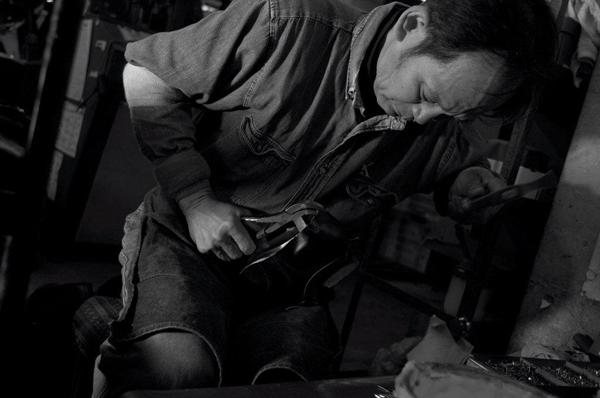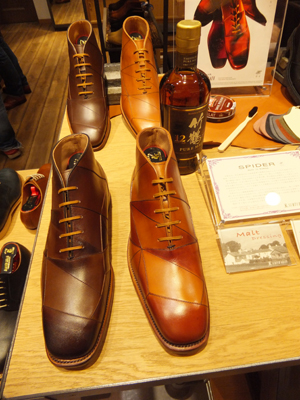To challenge the reputation of Italian leather makers, Japanese shoe maker, Scotch Grain is sticking to tradition. We spoke to them about the process and were impressed by their approach.
Pursuit of quality is the key,” says Masakazu Hirokawa, president of Scotch Grain, “we can not make more than 400 shoes per day and I have neither intention nor interest in increasing that number.”
Other players in the market have set up factories abroad, in places such as China but, again, Hirokawa is resolute on his local tradition. “We carefully screen and select leather materials,” he says, “and we put all of our pride, energy and affection into our products. They are produced one by one at the hands of our highly skilled craftsmen in Japan.”
The Scotch Grain brand was created by the Hirokawa Shoe Company, which was established by Hirokawa’s father, Goro Hirakawa, soon after World War II. Hirokawa Snr. is now chairman of the family business.
During and after the war, goods and commodities of every description were in short supply. If you had anything in your hand, whatever it was, it seemed you could sell it. However, Goro Hirokawa, as a salesman, didn’t want the opportunity to mean compromise.
He would not make cheap, albeit perfectly salable, shoes like all the others were doing. Instead, he stuck with his principle: the pursuit of quality. Other shoe companies often chose an easier path, Hirokawa Jr. explains, choosing so called license production, the manufacturing of shoes for pre-established brands. Goro Hirokawa, though, was particular about personal selection of leather and a bespoke process of design with specific customers in mind. Seeing his future in hand selected and hand made shoes, he created the Hirokawa Shoe Company.
Up until then Hirokawa were producing shoes using three traditional methods, the “cemented process”, the “McKay welt process” and the “Goodyear welt process.”
After president of Jun, the pre-eminent men’s fashion magazine of the time, persuaded Goro to launch what became the Scotch Grain brand, and find a way to distinguish it, this changed.
Welting is the process by which the many pieces of leather are fitted together to make a comfortable upper and sewn to the sole – which, in another impressive piece of attention to detail, varies in thickness depending on the height of the buyer. Cementing uses glue and other bonding agents but with a Goodyear machine, the shoes need only to be stitched. It is the most difficult, labour intensive, time-consuming process and is the toughest road but, it is the only one that would do.
This method of construction has many advantages. A Goodyear shoe is flexible, comfortable, durable and often more breathable than the average shoe. In 1978, Hirokawa Shoe Company started to sell their exclusively Goodyear welted original brand, Scotch Grain.
The welt enables shoes to be repaired over and over again, allowing the wearer, over many many years, to build up the highly desirable patina of a well-worn shoe. Incredibly, the founder’s son says, “some people wear one pair of our shoes for more than 20 years.”
Masakazu Hirokawa adds, “we have a great admiration for British craftsmanship, so our brand name reflects that aspect, but at the same time we are thinking that if we pursue quality in a traditional, diligent, Japanese way, considering our work to be ‘the art of shoe making’, we will eventually go beyond the European standard.”
The president himself actually goes to Italy and France to source the best leather. Many feel that their quality has already caught up with European standards but the pricing stays at around 1/3 of similar European models. A lot of western travellers are buying Scotch Grain, which are embossed with distinctive pebbled pattern, before they go back home.
“We are focusing on the 30,000 yen range in order for average business people to be able to buy our shoes and enjoy them for another 20 years,” Masakazu stresses. “Please come to our shops and try our shoes. They will follow you for next 20 years.”
He introduced Weekender to the company’s “malt dressing” method of shoe polishing, saying, “one of our old craftsmen taught me this tip.” We were intrigued. “Put some cream on your shoes, polish them, put some malt whisky on them and brush again. Your shoe shines amazingly.” And they did! “Do it in your living room, sip a bit of malt whiskey, listen to relaxing music, take 30 minutes for each shoe and you will not only have quality time but your shoes will stay with you for more than 20 years.”
Written by James K. Toda
Scotch Grain has a new shop in the Solamachi mall, which is part of the Tokyo Sky Tree complex.










